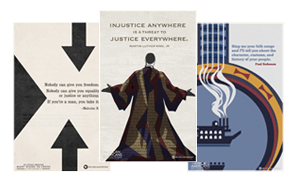Causes and Effects of Abolition ~ Lesson Plan
Lesson Overview
(Click here for a printer-friendly version of this lesson).
LESSON TITLE: Antebellum Agents of Change: Causes and Effects of Abolition
GRADE LEVEL: 9-10
TIME ALLOTMENT: Two 45-minute sessions
OVERVIEW
In this lesson, students explore the concept of “cause and effect” as it relates to the abolition of slavery in the United States in the 1800s. Using clips from the PBS series The African Americans: Many Rivers to Cross, students examine the causes and effects of events in the Antebellum period of American history that contributed to the end of slavery. Students also apply cause-and-effect-based thinking to current events. This lesson can be taught in a thematically-structured curriculum when teaching methods of historical thinking, or in a chronologically-structured curriculum leading up to the Civil War. The lesson reinforces two important tenets of historical study:
• Cause and effect analysis of major and minor events is a crucial component in the study of history; and
• Understanding the multiple factors that lead to, and arise from, events increase our comprehension of history as a whole.
SUBJECT MATTER: Social Studies, American History
LEARNING OBJECTIVES
After completing this lesson, students will be able to:
- Identify causes that led to the abolition of slavery;
- Incorporate “cause-and effect” into historical thinking;
- Project the effects that historical events may have on the future.
STANDARDS
From the Common Core Standards: English Language Arts, available online at
http://www.corestandards.org/ELA-Literacy:
Common Core Standards, now adopted in over 40 states, are designed to help educators prepare students for success in college and careers by focusing on core knowledge and skills. The English Language Arts standards reflect the need for young people “to read, write, speak, listen, and use language effectively in a variety of content areas” including history/social studies. This curricular resource developed to accompany The African Americans: Many Rivers to Cross aligns most closely with the following Common Core Standards:
- CCSS.ELA-Literacy.RH.9-10.2 Determine the central ideas or information of a primary or secondary source; provide an accurate summary of how key events or ideas develop over the course of the text.
- CCSS.ELA-Literacy.RH.9-10.3 Analyze in detail a series of events described in a text; determine whether earlier events caused later ones or simply preceded them.
From the National Standards for United States History for grades 5-12, available online at http://www.nchs.ucla.edu/Standards/us-history-content-standards:
United States Era 4
Expansion and Reform (1801-1861)
Standard 2
How the industrial revolution, increasing immigration, the rapid expansion of slavery, and the westward movement changed the lives of Americans and led toward regional tensions.
Standard 2D: The student understands the rapid growth of “the peculiar institution” after 1800 and the varied experiences of African Americans under slavery.
Grades 5-12: Identify the various ways in which African Americans resisted the conditions of their enslavement and analyze the consequences of violent uprisings.
Historical Thinking Standard 3
The student engages in historical analysis and interpretation:
Therefore, the student is able to:
- Analyze cause-and-effect relationships bearing in mind multiple causation including (a) the importance of the individual in history; (b) the influence of ideas, human interests, and beliefs; and (c) the role of chance, the accidental and the irrational.
- Hypothesize the influence of the past, including both the limitations and opportunities made possible by past decisions.
MEDIA COMPONENTS
Video
The African Americans: Many Rivers to Cross, selected segments.
Access the video segments for this lesson at the Episode Two Video Segments Page.
Segment 1: “Cotton Gin”
This video describes how the invention of the cotton gin revolutionized the worldwide textile industry, and with it the dynamics of the American slave community.
Segment 2: “Nat Turner Rebellion”
Learn about the Nat Turner Rebellion, and how it affected Southern slaveholders.
Segment 3: “Frederick Douglass”
This video describes the life of Frederick Douglass and his rise to prominence in the abolitionist community.
Segment 4: “Fugitive Slave Act”
In this video, learn about the Fugitive Slave Act of 1850, and what led to its implementation.
MATERIALS
For the class:
- Computer, projection screen, and speakers (for class viewing of online video segments)
- Chalkboard, whiteboard, or overhead projector
For each group:
- Flip chart paper and markers OR computer or tablet
PREP FOR TEACHERS
Prior to teaching this lesson, you will need to:
Preview all of the video segments used in the lesson. Prepare to watch them using your classroom’s Internet connection.
Find educational resources related to this program - and access to thousands of curriculum-targeted digital resources for the classroom at PBS LearningMedia.
Visit PBS Learning Media






